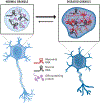RNA Droplets
- PMID: 32040349
- PMCID: PMC7695521
- DOI: 10.1146/annurev-biophys-052118-115508
RNA Droplets
Abstract
Liquid-liquid phase separation is emerging as the universal mechanism by which membraneless cellular granules form. Despite many previous studies on condensation of intrinsically disordered proteins and low complexity domains, we lack understanding about the role of RNA, which is the essential component of all ribonucleoprotein (RNP) granules. RNA, as an anionic polymer, is inherently an excellent platform for achieving multivalency and can accommodate many RNA binding proteins. Recent findings have highlighted the diverse function of RNA in tuning phase-separation propensity up or down, altering viscoelastic properties and thereby driving immiscibility between different condensates. In addition to contributing to the biophysical properties of droplets, RNA is a functionally critical constituent that defines the identity of cellular condensates and controls the temporal and spatial distribution of specific RNP granules. In this review, we summarize what we have learned so far about such roles of RNA in the context of in vitro and in vivo studies.
Keywords: RNA; RNA binding protein; aberrant aggregation; liquid–liquid phase separation; multivalency; polymer.
Figures





References
-
- Aumiller WM Jr., Keating CD. 2016. Phosphorylation-mediated RNA/peptide complex coacervation as a model for intracellular liquid organelles. Nat. Chem 8:129–37 - PubMed
-
- Aumiller WM Jr., Pir Cakmak F, Davis BW, Keating CD. 2016. RNA-based coacervates as a model for membraneless organelles: formation, properties, and interfacial liposome assembly. Langmuir 32:10042–53 - PubMed
Publication types
MeSH terms
Substances
Grants and funding
LinkOut - more resources
Full Text Sources

